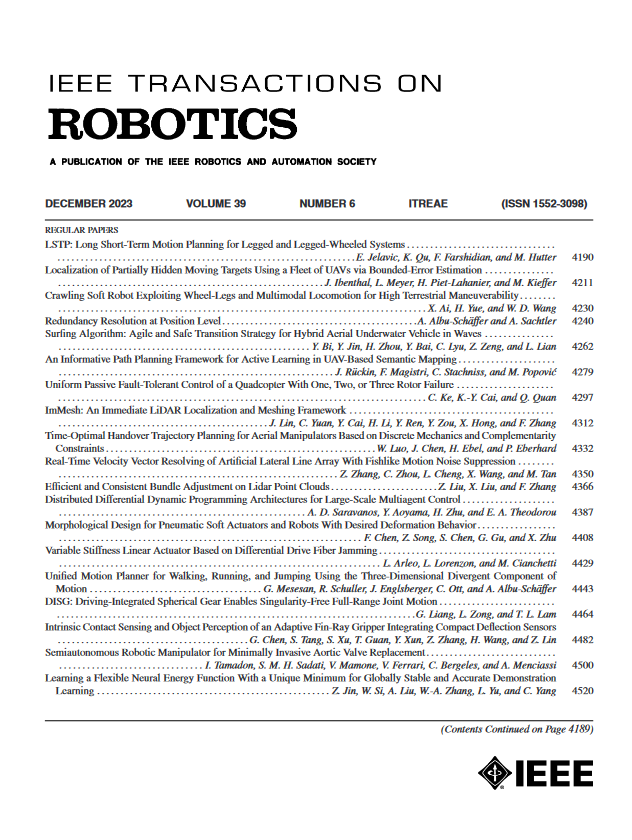Shear-Based Grasp Control for Multifingered Underactuated Tactile Robotic Hands
IF 9.4
1区 计算机科学
Q1 ROBOTICS
引用次数: 0
Abstract
This article presents a shear-based control scheme for grasping and manipulating delicate objects with a Pisa/IIT anthropomorphic SoftHand equipped with soft biomimetic tactile sensors on all five fingertips. These “microTac” tactile sensors are miniature versions of the TacTip vision-based tactile sensor, and can extract precise contact geometry and force information at each fingertip for use as feedback into a controller to modulate the grasp while a held object is manipulated. Using a parallel processing pipeline, we asynchronously capture tactile images and predict contact pose and force from multiple tactile sensors. Consistent pose and force models across all sensors are developed using supervised deep learning with transfer learning techniques. We then develop a grasp control framework that uses contact force feedback from all fingertip sensors simultaneously, allowing the hand to safely handle delicate objects even under external disturbances. This control framework is applied to several grasp-manipulation experiments: First, retaining a flexible cup in a grasp without crushing it under changes in object weight; Second, a pouring task where the center of mass of the cup changes dynamically; and third, a tactile-driven leader-follower task where a human guides a held object. These manipulation tasks demonstrate more human-like dexterity with underactuated robotic hands by using fast reflexive control from tactile sensing.基于剪切的多指欠驱动触觉机器人手抓取控制
本文提出了一种基于剪切的控制方案,用于抓取和操纵精细物体,该控制方案采用了比萨/IIT拟人化SoftHand,该SoftHand在五个指尖上都配备了柔软的仿生触觉传感器。这些“microTac”触觉传感器是基于触觉触觉传感器的微型版本,可以在每个指尖提取精确的接触几何形状和力信息,作为控制器的反馈,在握住物体时调节抓取。采用并行处理流水线,从多个触觉传感器中异步捕获触觉图像并预测接触姿态和力。所有传感器的一致姿态和力模型都是使用监督深度学习和迁移学习技术开发的。然后,我们开发了一个抓取控制框架,同时使用来自所有指尖传感器的接触力反馈,使手即使在外部干扰下也能安全地处理精致的物体。该控制框架应用于几个抓取操作实验:首先,在物体重量变化的情况下,将一个柔性杯子保持在抓取中而不压碎;第二种是杯子的质心动态变化的倒杯任务;第三个是触觉驱动的领导者-追随者任务,即人类引导手持的物体。这些操作任务通过使用来自触觉感应的快速反射控制,在欠驱动的机器人手中展示了更像人类的灵巧性。
本文章由计算机程序翻译,如有差异,请以英文原文为准。
求助全文
约1分钟内获得全文
求助全文
来源期刊

IEEE Transactions on Robotics
工程技术-机器人学
CiteScore
14.90
自引率
5.10%
发文量
259
审稿时长
6.0 months
期刊介绍:
The IEEE Transactions on Robotics (T-RO) is dedicated to publishing fundamental papers covering all facets of robotics, drawing on interdisciplinary approaches from computer science, control systems, electrical engineering, mathematics, mechanical engineering, and beyond. From industrial applications to service and personal assistants, surgical operations to space, underwater, and remote exploration, robots and intelligent machines play pivotal roles across various domains, including entertainment, safety, search and rescue, military applications, agriculture, and intelligent vehicles.
Special emphasis is placed on intelligent machines and systems designed for unstructured environments, where a significant portion of the environment remains unknown and beyond direct sensing or control.
 求助内容:
求助内容: 应助结果提醒方式:
应助结果提醒方式:


